How to Identify Center Draft and
Kosmos Lamps
And once identified by type of lamp (center
draft, Kosmos or flat wick) you can
then
identify the typical
type or the "pattern" of the lamp and the
original intended
use.
Often parts are missing which can obscure the original use
concept.
The
nomenclature of the lamp parts are the same for all oil lamps;
LANTERNS have different part names. For example, lamps have
"chimneys" which are held in place on the bottom of the chimney
whereas lanterns have "globes" which are held in place top and
bottom.
Oil Lamp parts by name, courtesy of Dr. Courter.
Aladdin
lamp parts.
Coleman mantle lantern parts courtesy of
Old Town Coleman Center,
and
pressure gasoline lantern parts.
|
Often the only photo sent with a request to me for
identification does not show ''the lamp.''
Nice photo but the shade covers the actual "lamp'' completely
- there are no clues whatever that can be used to identify the
lamp - or the lamp parts! The
nomenclature of the lamp parts are the same for all oil lamps,
whether Aladdin mantle lamps, center draft lamps or Kosmos
lamps. |
 |
Flame Spread Clearly Shows The Manufacturer...but
not the size
|
Remove the shade and low and behold, there is
a flame spreader that answers the question of identity! |
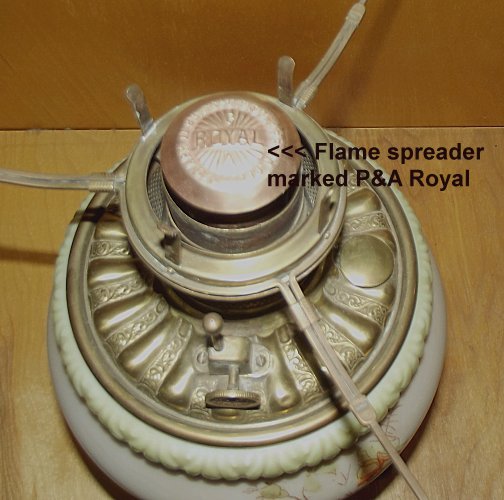 |
 |
No Markings on Lamp But Lots of Clues!!!
|
No flame spreader, no markings on lamp, so the
clues needed are best done with a photo of the burner in
profile with the wick knob facing the camera. Now we can
see the burner configuration, the wick knob and the
embossing
pattern. By reviewing Courter's Center Draft Lamp
book, we can see those clues indicate the lamp was made by P&A
between 1892 and 1898 and is a #2 P&A Royal burner on a drop-in font
or "pot insert" font often used in GWTW lamps made by
Consolidated, Fostoria and others with the
flame spreader marked with the brand name of the company
which made the glassware part of the lamp. |
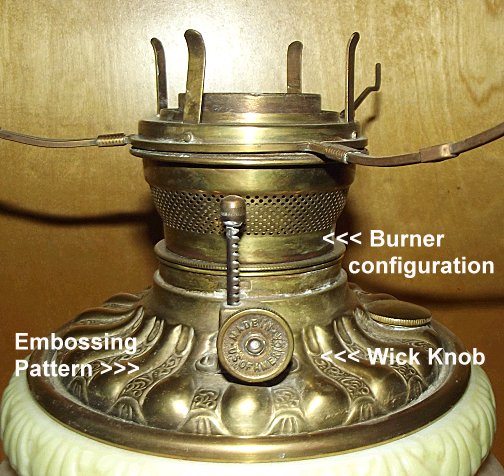 |
Draft tube and Outer Wick Tube Equal Height
|
A photo from this angle shows the center draft
tube ("C") and the outer wick tube ("O") are the same height.
If the lamp had been electrocuted for the addition of an
electrical light bulb socket the center draft tube would have
most likely been cut down. That is a MAJOR problem as
the lamp could not be restored to liquid fuel without a
replacement of the draft tube.
Measuring the INSIDE DIAMETER of ''C" and the
OUTSIDE DIAMETER of "O" will allow the determination of the
SIZE of the burner and thus the wick required. |
 |
Some center draft lamps have been modified to hold
an electrical socket and CANNOT be easily converted to again be
''oil lamps,'' and some sellers on eBay do not know what they have
or fail to disclose their lamps have been ''electrocuted.''
|
At right is an example of a cut-down center
draft tube. The tube is visibly irregular on top with sharp
edges. Not having the burner installed does not show how
much shorter the center draft tube (#C in photo above) is than
the outer wick tube (#0 in photo above), sorry, but with the
burner installed the height difference would be a noticeable.
An example of a
drastically cut down draft tube is here (click).
Every manufacturer of lamps used their own
dimensions when drawing the draft tubes so simply taking a
draft tube from any old center draft tube is NOT a suitable
replacement - the draft tube almost always must come from an
identical make and model of center draft lamp.
At right is a "pot insert" often used in
GWTW
and "vase" lamps; the photo shows there are no
vertical stress cracks in the font so
no repair
is needed there. |
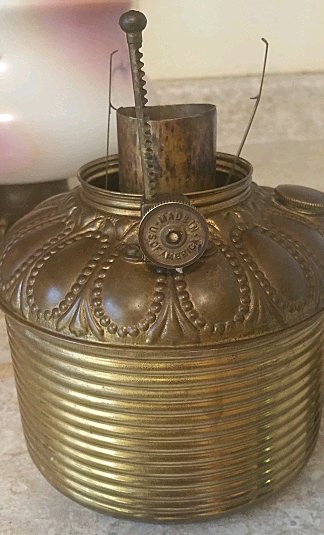 |
A missing flame spreader can often be replaced as
they can often be found on eBay.
But the exact model of the lamp -
not just the manufacturer - MUST be identified as
the flame
spreaders were specifically designed for individual burners. I can
help with
identification if I have all of the markings on the lamp
and wick knob along with properly
sized photos showing the burner
IN PROFILE WITH THE WICK KNOB FACING THE
CAMERA and the embossing
pattern (if any) clearly visible.
miles@milesstair.com
Burner Damage
|
A photo of any damage to the burner will
reveal if the burner can be repaired or used as-is.
Click on the photo at right and you will see a horizontal
crack in the gallery right below the chimney seat. In
this case the burner could still be used. Notice in this photo
the wick knob is centered and readable and the chimney gallery
is in profile and
the gallery can be measured to get a correct chimney fit. Click on the photo
at right to enlarge it. |
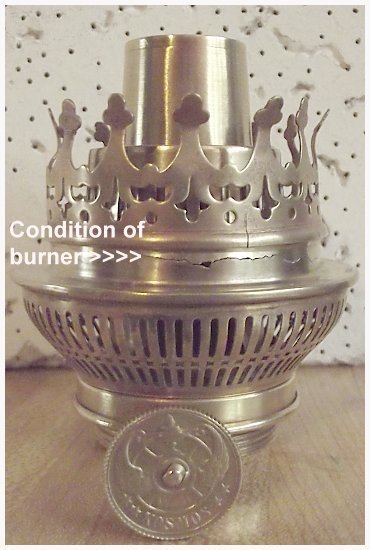 |
Identification of Kosms Burners
|
The photo near right shows a typical
side-draft Kosmos air cutout in the outer wick tube.
The photo far right shows the wick tube is
clearly marked for the size and type of burner - in this case
it is a 14''' Kosmos. Not all Kosmos burners are so
nicely marked. |
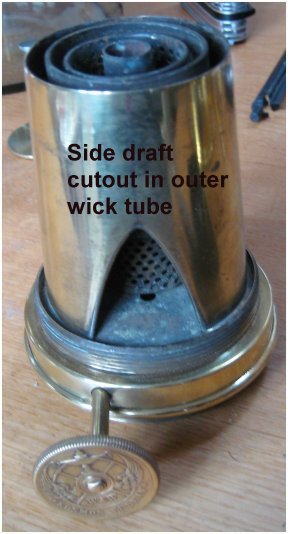 |
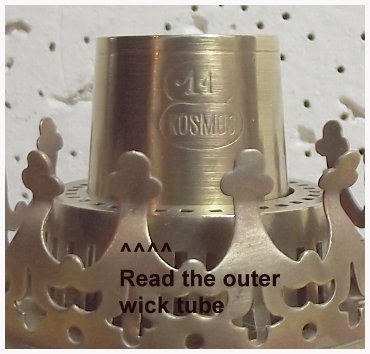 |
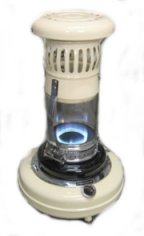
 . .
. .







